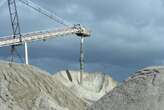In another move from the Trump administration aimed at disrupting climate science, the Commerce Department has ordered NOAA, the National Oceanic and Atmospheric Administration, to search grants for climate-change-related terms, signaling that it may work to cancel that funding. It’s a move that could threaten a wide array of projects—including infrastructure work on bridges and roads—and leaves researchers uncertain about the future of their work.
NOAA is one of the world’s leading climate science agencies, and it funds work on everything from atmospheric studies to wildfires to fishery recovery. NOAA also has funding available through the Bipartisan Infrastructure Law for habitat restoration, coastal resilience, and weather forecasting.
The Trump administration’s directive to search grants for climate terms includes words like climate, climate science, carbon, environmental quality, and pollution. This follows the move from Elon Musk’s Department of Government Efficiency to search NOAA databases for “DEI content.”
But terms like diversity could come up in discussions about ecological or biodiversity, researchers say—and climate terms are ubiquitous in everything the agency works on. “You’re going to have a hard time finding grant awards that don’t mention climate change, simply because of its role in all of these areas of science,” says Douglas Price, whose work has focused on grant funding and climate research. “It speaks to the blunt-force approach that’s being taken across the government right now.”
Infrastructure projects are tied to climate science
By singling out climate-related terminology, all types of NOAA-funded work could be under threat. That includes infrastructure projects that have to take climate impacts into consideration—basically, “anything you build,” Price says. “Anything that uses concrete, steel, asphalt, you have to be looking at extreme heat and extreme precipitation events. If you’re going to exclude climate change from the planning and engineering of any sorts of projects, you’re making them vulnerable to climate extremes that we’re seeing with regularity now.”
Whether in a tiny, coastal New England town or a major city like New York, infrastructure like roads, bridges, rail lines, and tunnels must consider climate threats. “What are the new temperature extremes that we’re going to see? What is the new baseline for 100-year storms? What are the flooding extremes we’re going to see and how do we size storm sewers?” Price says. Infrastructure projects are meant to last decades, so we can’t build new bridges, for example, only for the climate extremes we’re currently experiencing; we have to think about the projected extremes we’ll see in 50 years.
Already, our current infrastructure is at risk. One environmental nonprofit worker, who spoke on the condition of anonymity because of fears that his organization could be targeted by the administration, is concerned about this directive affecting existing agreements. His nonprofit uses funding that comes from other organizations via NOAA grants. One recent project involves designing and building two bridges to replace undersized culverts.
When culverts are too small, the water flowing through them is stronger, which enhances erosion, blocks fish from passing through, and risks washing out structures. “These culverts increase the risk of road failure and are barriers to spawning migration for salmon species,” the worker says. “These projects all explicitly mention ‘climate change’ and ‘habitat diversity.’ These phrases are in there because NOAA guidance is to design road crossings to account for anticipated changes due to climate change.”
Overall, ignoring climate impacts doesn’t stop them from happening—it just stops us from being prepared. By banning certain terms, Price says, “You’re blindfolding yourself and walking into a strange room, and you know that there are lots of sharp objects in that room you can stumble into, but you’ve chosen to not look for them.”
A matter of life and death for at-risk communities
Other NOAA-funded work is more on the nose when it comes to climate change, like mitigation efforts or environmental justice projects—both specifically on Trump’s radar for cuts. This isn’t work being done in some lab that has implications for far into the future. It’s being applied “almost immediately to problems that we face,” Price says.
Grants help connect research institutions with vulnerable communities and the government agencies that can provide them resources. That could mean communicating flood risks to coastal communities or ensuring that the recovery efforts for the Los Angeles wildfires aren’t leaving less-wealthy communities behind.
Or take an impact like extreme heat, which poses special risk for communities with lots of elderly residents or people with disabilities. “If we can’t understand those risks and where the vulnerabilities are, and if we can’t help policymakers come up with ways of getting support to those communities, more people will die when we have extreme heat events than would otherwise,” he says.
This holds true for any extreme weather event. “The main reason we want to understand climate change and that we want to increase resilience to impacts is because those impacts often are life-and-death matters to people,” Price adds. “These things aren’t abstract. They aren’t a game. We’re honestly very concerned about people’s lives in the work that we do.”
“A cloud of uncertainty” for researchers
A larger issue with targeting specific terms like climate or diversity is that it removes them from crucial context. “You can’t talk about statistics without talking about bias; you can’t talk about IT security without talking about privilege; you can’t talk about any population of humans, animals, or bacteria without talking about population diversity,” Price says. Sifting through the results requires a certain understanding of these topics, one that the nonprofit worker doubts young DOGE workers have.
The administration’s approach isn’t necessarily meant to be productive or exact. Instead, Price notes, it’s a way of creating a political climate where these topics feel threatened, and “if you’re involved with these things, you’re at risk.” With agency-level communication largely shut down and ever-changing orders, it’s difficult to know how this will all proceed—whether grants will actually be cut short, whether the courts will step in, whether researchers need to think about working with Congress. “There’s a large cloud of uncertainty around how all of this is being done,” he says.
That means many researchers and their institutions are still looking for the best pathway to defend their work. But for climate researchers, antagonism isn’t totally new. “Climate scientists are quite used to being attacked politically,” Price says. It’s just that now the attacks are focused on “a particular vulnerability in science in general, which is the way that it is funded by the federal government.”









No comments